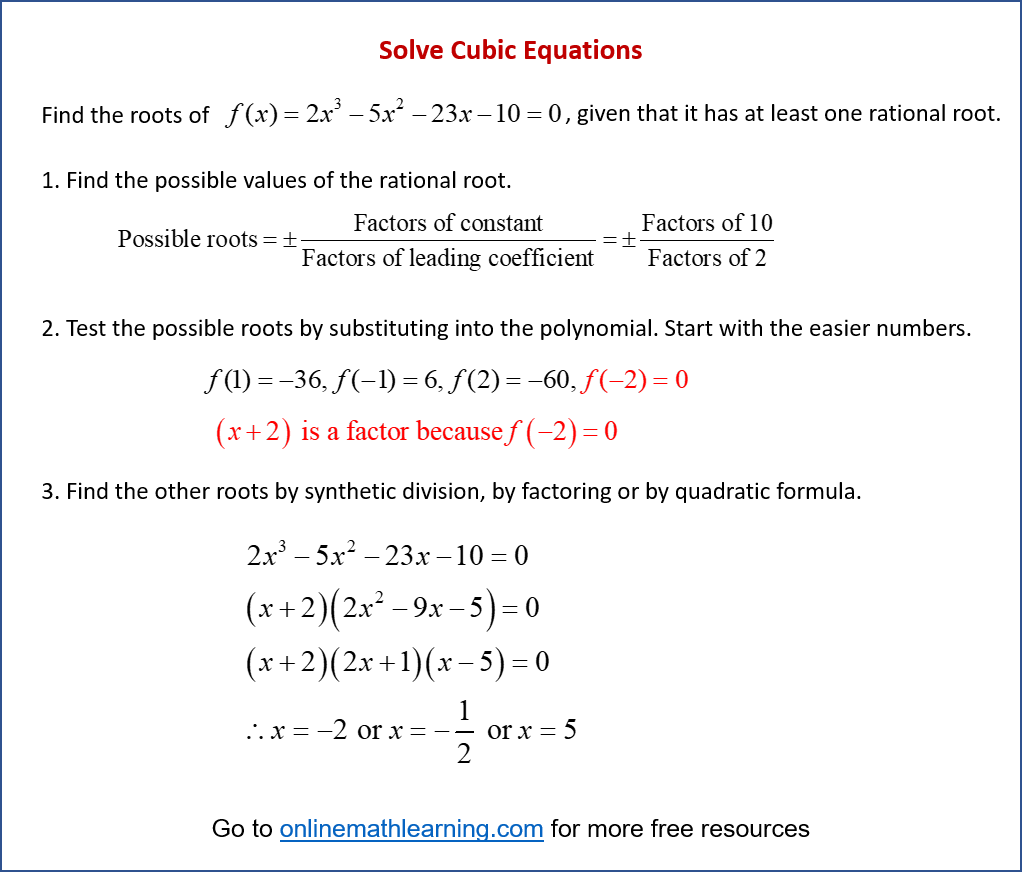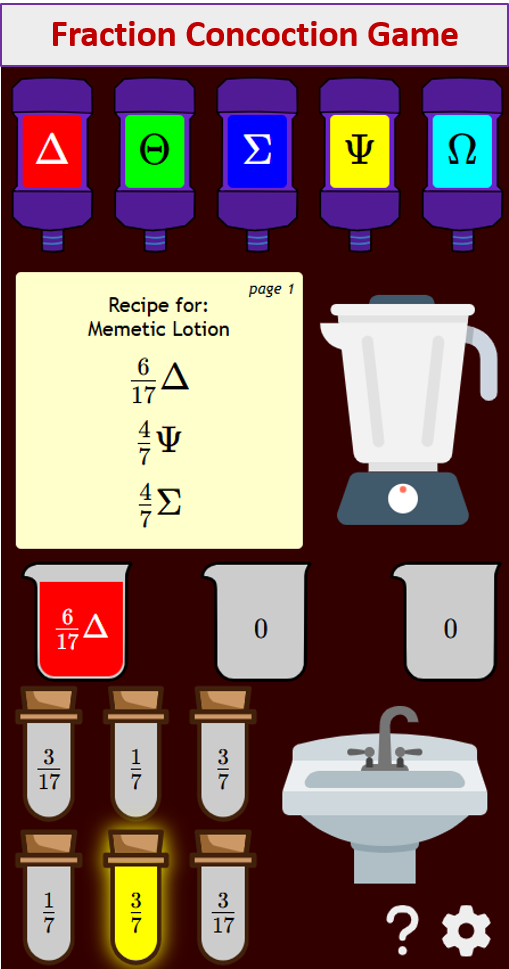Solving Cubic Equations
Related Pages
Cubic Functions
Factor Theorem
Remainder Theorem
More Algebra Lessons
More Algebra Games
In these lessons, we will learn how to solve cubic equations using the Remainder Theorem and the Factor Theorem.
Solving cubic equations often relies heavily on the Factor Theorem and the Remainder Theorem, particularly when you’re looking for rational roots. These theorems provide a powerful method to simplify a cubic equation into a quadratic one, which is then much easier to solve.
What is the Remainder Theorem?
If a polynomial P(x) is divided by a linear divisor (x − a), then the remainder of that division is P(a).
In simpler terms: To find the remainder when dividing a polynomial by (x − a), just substitute a into the polynomial.
What is the Factor Theorem?
A special case of the Remainder Theorem.
If P(a) = 0, then (x − a) is a factor of the polynomial P(x).
Conversely, if (x − a) is a factor of P(x), then P(a) = 0.
This means that if substituting a value a into a polynomial results in zero, then a is a root (or zero) of the polynomial, and (x − a) is a factor.
How to solve cubic equations using the Factor Theorem?
In these lessons, we will consider how to solve cubic equations of the form
px3 + qx2 + rx + s = 0 where p, q, r and s are constants by using the
Factor Theorem and Synthetic Division.
The following diagram shows an example of solving cubic equations. Scroll down the page for more examples and solutions on how to solve cubic equations.

Algebra Worksheets
Practice your skills with the following Algebra worksheets:
Printable & Online Algebra Worksheets
Steps to Solve a Cubic Equation Using These Theorems
- Find a Rational Root using the Remainder Theorem (and Rational Root Theorem).
Rational Root Theorem: This theorem helps you identify a list of possible rational roots. If a polynomial P(x) = axn + … + d has integer coefficients, then any rational root x = \(\frac{p}{q}\) must have p as a factor of the constant term d, and q as a factor of the leading coefficient a.
List all factors of d (these are your possible numerators, ±p).
List all factors of a (these are your possible denominators, ±q).
Possible roots ±\\(\\frac{p}{q}\\).
Test the possible roots by substituting into the polynomial. Start with the easier numbers.
Stop when you find one where P(x) = 0.
According to the Remainder Theorem, if P(a) = 0 for a particular value a, then a is a root of the equation. This means (x − a) is a factor of P(x).
-
Use Synthetic Division (or Polynomial Long Division) to Depress the Polynomial.
Once you’ve found a root a (and thus a factor (x − a)), divide the original cubic polynomial P(x) by (x − a).
Synthetic division is usually much faster for this.
The result of this division will be a quadratic polynomial (a polynomial of degree 2) and a remainder of zero (since (x − a) is a factor). -
Solve the Quadratic Equation.
The quadratic polynomial you obtained from Step 2 can be solved using any standard method for quadratics: Factoring, Quadratic Formula or Completing the Square.
This will give you the remaining two roots of the cubic equation. These roots can be real or complex. -
List all Roots.
Combine the root you found in Step 1 with the two roots you found in Step 3. These are the three roots of your cubic equation.
Example:
Find the roots of f(x) = 2x3 + 3x2 – 11x – 6 = 0, given that it has at least one integer root.
Solution:
Since the constant in the given equation is a 6, we can try the factors of 6.
The possible values are \(\pm 1,\pm 2,\pm 3,\pm 6 \)
Step 1: Use the factor theorem to test the possible values by trial and error.
f(1) = 2 + 3 – 11 – 6 ≠ 0
f(–1) = –2 + 3 + 11 – 6 ≠ 0
f(2) = 16 + 12 – 22 – 6 = 0
We find that the integer root is 2.
Step 2: Find the other roots either by inspection or by synthetic division.
2x3 + 3x2 – 11x – 6
= (x – 2)(ax2 + bx + c)
= (x – 2)(2x2 + bx + 3)
= (x – 2)(2x2 + 7x + 3)
= (x – 2)(2x + 1)(x +3)
So, the roots are x = 2 or -\(\frac{1}{2}\) or -3
Example:
Solve the cubic equation x3 – 7x2 + 4x + 12 = 0
Solution:
Let f(x) = x3 – 7x2 + 4x + 12
The possible values are ![]()
We find that f(–1) = –1 – 7 – 4 + 12 = 0
So, (x + 1) is a factor of f(x).
x3 – 7x2 + 4x + 12
= (x + 1)(x2 – 8x + 12)
= (x + 1)(x – 2)(x – 6)
So, the roots are –1 or 2 or 6.
Videos
What are The Remainder Theorem and the Factor Theorem?
How to use the Theorems to find the linear factorization of a polynomial?
Example: Factor F(x) = 2x3 − 3x2 − 5x + 6
How to use the Factor Theorem to factor polynomials?
Examples:
- Factor P(x) = 3x3 − x2 − 10x + 8
- Factor P(x) = 2x3 − 9x2 + x + 12
How to use the Factor Theorem to solve a cubic equation?
If f(x) is a polynomial and f(p) = 0 then x - p is a factor of f(x)
Example: Solve the equation 2x3 −5x2 − 10 = 23x
How to solve Cubic Equations using the Factor theorem and Long Division?
Example: Find the roots of the cubic equation 2x3 − 6x2 + 7x − 1 = 0
How to solve Cubic Equations using the Factor theorem and Synthetic Division?
Example: Show that x + 3 is a factor of x3 − 19x − 30 = 0. Then find the remaining factors of f(x)
How to solve cubic equation problems?
Example: 3x3 −4x2 − 17x = x3 + 3x2 − 10
Step 1: Set one side of equation equal to 0.
Step 2: Collect like terms.
Step 3: Factorize using the Factor Theorem and Long Division
Try out our new and fun Fraction Concoction Game.
Add and subtract fractions to make exciting fraction concoctions following a recipe. There are four levels of difficulty: Easy, medium, hard and insane. Practice the basics of fraction addition and subtraction or challenge yourself with the insane level.

We welcome your feedback, comments and questions about this site or page. Please submit your feedback or enquiries via our Feedback page.